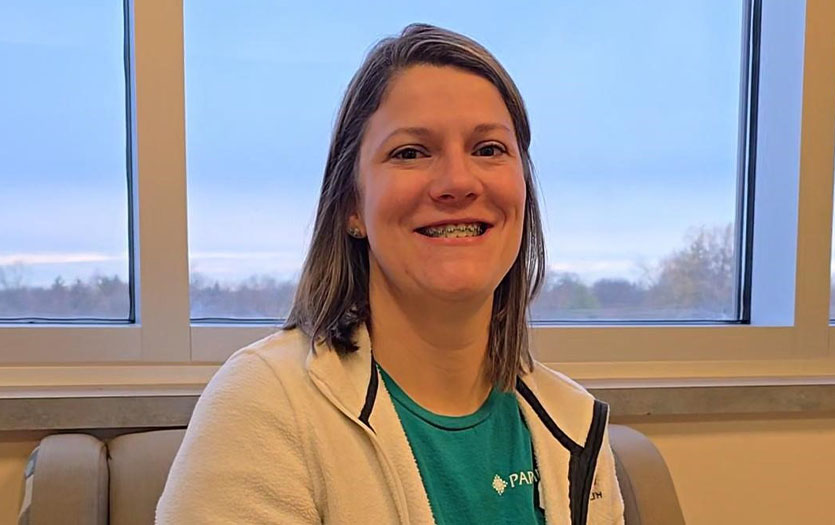Enjoy this monthly mindfulness post from Dave Johnson, PhD, CNS- BC, LMFT, employee assistance specialist.
Are you breathing?
Seriously … are you breathing? At first, this sounds like a silly or nonsensical question. But when you pause and notice your breathing, you gain an awareness that in essence your body breathes you 99.9 percent of the time, on autopilot. In this moment of focused attention, you can shift yourself off autopilot breathing and intentionally breathe your body.
Sounds simple right?
Well as mundane as it is, we all know how important the work of the breath is. We inhale oxygen which nourishes all the cells within us and exhale carbon dioxide, the waste disposal, with each outbreath. The chest rises and falls, and the mechanical exchange of renewal is a beautiful system of flow. I marveled watching my children take their first breath at birth. I reminisced and said goodbye as I witnessed both my oldest son and my aging parents take their last breaths. I breathed multiple frantic breaths into my daughter during a near-drowning incident. When breathing works, we take it for granted. When it falters, we recognize the peril.

The rhythm and rate of breathing also varies with our emotional patterns (i.e. angry, anxious, stressed, startled), sleeping (relaxed), physical exertion (labored), and pain (shallowed or challenged). For the most part, we appreciate but don’t notice the regular ebb and flow. As a nurse and psychotherapist, I teach patients and community members about the powerful, portable and transformative process of mindfulness and breathing to help facilitate stress reduction and healing of ourselves, families, and communities.
And so I ponder about mindfulness and breathing:
- Notice breathing. Having awareness of breathing shifts me from the “monkey” ruminative mind of thinking to a place of rhythm and flow. This liminal (threshold) space of awareness is a great place to begin to notice patterns. Coming out of my stress-filled thinking brain and giving myself a few moments to slow and calm is good medicine for the body and soul.
- Experiment with noticing. I am a runner, and often I can spend an entire run problem-solving, processing my day, or escaping my thinking or stress brain while listening to podcasts or music. But another intentional, mindful way to approach my run is to periodically see if I can sustain awareness of breathing patterns. The other environmental cues (sights, sounds, smells, etc.) become a backdrop but not the central focus during the run. My intention is simply sustaining awareness of the pattern of my breathing (rate, rhythm, labor, movement, exchange, etc.). Trying to maintain this awareness over my 30-40-minute run can be quite the challenge. Building the muscle of focused awareness is part of the art of mindfulness.
- Check out your children’s breathing patterns. One of the greatest blessings as a parent is when the kids or grandkids are in bed and sleeping peacefully. Perhaps it was a busy or stress-filled day and getting the kids to bed was no easy chore. But at day’s end, noticing how children’s bellies move when they breathe and the calm rhythm can be a moment of pause and reflection of goodness. Set the intention to milk the awareness of this moment for a minute or two; Longer than you would on autopilot, when you might just steal a quick peek. Attempt to breathe the child’s pattern and come into the same synchronicity of calm. Ahhh … Give it a try!
- Hand over. Put your right hand over your heart. I know it sounds a bit patriotic but this gesture is a noble act of pause and loving kindness. Next time you feel very stressed or anxious try a bit of self-compassion and self-soothing touch. For me, I hold tension in my chest region and simply pausing and touching the tightened muscles over my heart and noticing my breathing pattern triggers a cascade of calm and relief. I notice my chest rising and falling and gently feel the wave of flow. I set the intention of slowing the flow just a little and sense some relief from the barrage of internal and external stressors coming my way.
- Inhale through nose. Usually, when I teach others about mindfulness, I highlight how it is more important to notice how one breathes than actually changing the pattern. But making an intentional shift from inhaling through the mouth to inhaling through the nose can have benefits. The nose moistens, filters, and gently warms the air that we inhale. The nose is a bit more sensitive to notice the air’s temperature, and smoothness of passage. Following the flow as far as we can all the way through to the expanding lungs is soothing. This is most relevant with fear, anxiety, or pain. On autopilot, emotional breathing leaves us feeling exhausted. Be deliberate about bringing the clean, refreshing, life-giving nourishment of air to cells that need to heal. This can also help one cope with the external or internal stressors perhaps outside of their control.
- Exhale through pursed lips. Again, the action of mindfulness is observing patterns, but in some situations, taking the wisdom to slow the exhalation as if blowing slowly through a straw will enhance the amount of oxygen that is actually being absorbed. More oxygen in the blood signals the heart to slow and the blood pressure to lower, muscles to relax, and a cascade of internal healing responses. Being mindful of exhaling completely is equally important. This assures that all of the air in the lungs is expelled and toxins removed before the next healing breath.
- Remember mama words. When I was a child, I had a bad temper and would say or do things that would get me into a bit of trouble. My mother was not one to discipline much, but would use those moments to teach. One message I heard more than a few times was, “Take a slow deep breath and count to ten before you do or say something you will later regret.” So in essence Mom was my first mindfulness guru. Sometimes before I send a retaliatory email or text out of anger or frustration I will recall her words. In the heat of an intense argument, I try to focus simply on breathing and capacity to be a watcher or observer of the situation. Buying a little non-reaction time can serve one well, though, admittedly, it isn’t always easy to do and requires practice.
- Watch your dog or cat breathe. Often pet lovers describe the therapeutic benefit of the unconditional love of a household pet. Pets have a way of not overthinking or judging and a provide uncomplicated companionship and love. Animals can observe the emotional patterns of their owners and can be quick to provide a bit of needed soothing to very stressful situations. Pet owners describe a gentle quickening of calm when they are in close synchronicity with their animals breathing pattern. Pur-poseful pausing. Ha!
- Watch the world breath. Our world pulsates with patterns and rhythms. Clouds move. Oceans wave. Eyelids flutter. Hearts beat. Lungs breathe. And every cell within us moves. Movement, rhythm, and patterns sustain the dance of life energy. Still water becomes a stagnant pond and at death our bodies fuse with other organic material to become part of a living, breathing, vibrant echo system. Pausing to notice these patterns is more than a good idea, but life-giving to the individuals, families, and communities who intentionally protect, respect, and appreciate the ecosystem. Care.
- Seek resources. Breathing exercises and mindfulness-based practice promotes a sense of balance and health. Finding resources to nurture and build this skill can be helpful. Parkview Center for Healthy Living has several intensive and introductory programs.
Try a guided meditation with Dr. Johnson.
Find a relaxing space and follow along as he leads you through a brief mindfulness practice*.
Mindfulness-based stress reduction practice has been extensively researched and proven helpful for coping with changes, grief, healthy eating patterns, pain, anxiety, depression and many other chronic disease and autoimmune disorders. For more on stress management programs and techniques, contact the Parkview Center for Healthy Living at (260) 672-6500. Dr. Johnson also provides on-site guidance for teambuilding and transformational leadership, among other topics. To learn more about Employees Assistance Programs for your company, call Business Development at (260) 373-9013.
*Dr. Johnson cautions anyone practicing this meditation to avoid doing so while driving or doing any other activity that requires your absolute concentration.
Other resources:
InvisibleInklings.com - Sign up for a free monthly mindful healing exercise from Dr. Dave.



